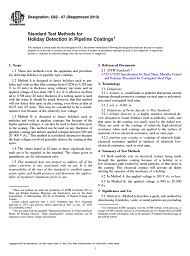We need your consent to use the individual data so that you can see information about your interests, among other things. Click "OK" to give your consent.
ASTM G62-07(2013)
Standard Test Methods for Holiday Detection in Pipeline Coatings
STANDARD published on 1.6.2013
The information about the standard:
Designation standards: ASTM G62-07(2013)
Note: WITHDRAWN
Publication date standards: 1.6.2013
SKU: NS-57760
The number of pages: 4
Approximate weight : 12 g (0.03 lbs)
Country: American technical standard
Category: Technical standards ASTM
Annotation of standard text ASTM G62-07(2013) :
Keywords:
holiday detector, holidays, piping, pinhole, wet sponge detector, ICS Number Code 23.040.99 (Other pipeline components)
Additional information
| Significance and Use | ||
|
5.1 Method A—Method A describes a quick, safe method for determining if pinholes, voids, or metal particles are protruding through the coating. This method will not, however, find any thin spots in the coating. This method will determine the existence of any gross faults in thin-film pipeline coatings. 5.2 Method B—Method B describes a method for determining if pinholes, voids, or metal particles are protruding through the coating, and thin spots in pipeline coatings. This method can be used to verify minimum coating thicknesses as well as voids in quality-control applications. |
||
| 1. Scope | ||
|
1.1 These test methods cover the apparatus and procedure for detecting holidays in pipeline type coatings. 1.2 Method A is designed to detect holidays such as pinholes and voids in thin-film coatings from 0.0254 to 0.254 mm (1 to 10 mils) in thickness using ordinary tap water and an applied voltage of less than 100 V d-c. It is effective on films up to 0.508 mm (20 mils) thickness if a wetting agent is used with the water. It should be noted, however, that this method will not detect thin spots in the coating, even those as thin as 0.635 mm (25 mils). This may be considered to be a nondestructive test because of the relatively low voltage. 1.3 Method B is designed to detect holidays such as pinholes and voids in pipeline coatings; but because of the higher applied voltages, it can also be used to detect thin spots in the coating. This method can be used on any thickness of pipeline coating and utilizes applied voltages between 900 and 20 000 V d-c.2 This method is considered destructive because the high voltages involved generally destroy the coating at thin spots. 1.4 The values stated in SI units to three significant decimals are to be regarded as the standard. The values given in parentheses are for information only. 1.5 This standard does not purport to address all of the safety concerns, if any, associated with its use. It is the responsibility of the user of this standard to establish appropriate safety and health practices and determine the applicability of regulatory limitations prior to use. |
||
| 2. Referenced Documents | ||
|
We recommend:
Technical standards updating
Do you want to make sure you use only the valid technical standards?
We can offer you a solution which will provide you a monthly overview concerning the updating of standards which you use.
Would you like to know more? Look at this page.




 Cookies
Cookies
